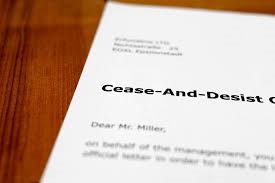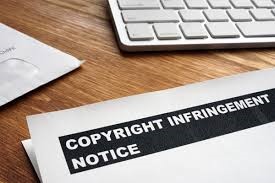Introduction
A cease and desist letter is a fair warning letter that is sent to an offender and comprises the allegations of acts or omissions. The letter also demands that the perpetrator ceases to continue doing the wrong actions. Moreover, a cease and desist letter normally gives notice of any legal action that could be resorted to in the event the wrongful conduct does not stop. A cease and desist notice is normally drafted by a lawyer and is often meant to bring an end to the actual or alleged violation of intellectual property entitlements such as patents, copyrights and trademarks.
Furthermore, a cease and desist notice could be utilized in warning the perpetrator against slander, harassment, libel and breach of contract. Though a cease and desist notice is not a binding letter and lacks legal impact, it is often shared to the perpetrator and may be relied on as proof in court against the perpetrator. This happens when the perpetrator does not quit doing the alleged wrong actions.

Understanding a cease and desist letter
A cease and desist letter is a formal document that warns another party of any wrong actions. It also informs the wrongdoer of any possible penalties if the wrong actions are not stopped. Moreover, a cease and desist notice does not necessarily result in a law suit. Some of the ways in which intellectual property rights can be violated include plagiarism, use of someone else’s invention without their consent and engagement in suspicious or illegal action that entail someone else’s personal work. These issues can be dealt with by sending a cease and desist letter to the alleged perpetrator. The letter serves as a formal notice to the wrongdoer and informs them of their engagements in the unlawful usage of property. The cease and desist notice also advises the to quit taking any further wrongful actions.
A cease and desist letter is also referred to as a cease and desist form, cease and desist notice, stop harassment letter or demand letter. All the preceding constitute official letters that warn one of certain unlawful activities against the aggrieved person.
Cease and Desist Order
A cease and desist order is fundamentally different from a cease and desist letter. One major disparity is their lawfulness. Most letters, including the letter, lack any legal force. Nonetheless, unlike a cease and desist letter, a cease and desist order has legal standing. Normally, a cease and desist order is given by the court and acts as a temporary order. Further, the party receiving the order should quit the unlawful actions until the court trial is held. After the court process, the court may issue a permanent order.
Some of the justifications of a cease and desist order include libel which denotes someone defaming another in print form. The slander which comprises defamation in verbal form.
Uses of Cease and Desist Letter
There exist various instances that could lead to one issuing a cease and desist letter or notice which include:
- Defamation, slander, libel and character assassination
- Infringement of trademark
- Infringement of copyright
- Infringement of patent, either utility or design
- Violating a non-compete clause in an agreement
- Any form of harassment. This includes debt collectors as provided for under the Fair Debt Collections Practices Act
- Contractual agreement violation
A cease and desist letter is also significant in stopping any form of contributory infringement. The preceding denotes one deliberately contributing to the violation without being actively involved. The same is also referred to as contributory or secondary liability.
- Patent, Copyright and Trademark Protections
The protection of patents, copyrights and trademarks are the main mechanisms of safeguarding intellectual property entitlements. Copyright and trademarks come in handy when one authors the property in question. Hence a cease and desist letter could be used in the quest of protecting the intellectual property rights when there is a threat or actual violation.
The intellectual property protections also apply when one uses a certain phrase, brand and dress of trade in relation to the official practice. Moreover, filing formal paperwork for the same is optional and the registration of the protections is of much probative value in court. Contrariwise, patents are expensive and convoluted. This is because they have to be registered to protect the inventions as well as processes that back their functions.

- Character Assassination
It is unlawful to say untrue things regarding people. This is most especially when the same has a resultant adverse effect on their reputation and freedom to partake in meaningful activities. People are allowed to express their opinions regarding someone but any false statements are followed by lawful consequences under the civil law. For instance, stating that another person is a jerk or that one engages in illegal activities is a form of character assassination. The preceding normally applies unless the same can be justified by aspects such as fair comment or the truth. Thus upon character assassination, the aggrieved party can share a cease and desist letter to serve as a fair warning of continuance of the said illegal action.
- Agreements and Contracts
Whenever one signs an agreement or contract, one is bound by the terms contained in the same. The contract could need a certain form or mannerisms from the parties. In the event one fails to follow the said contractual terms, one is considered to be in fundamental breach. If one agrees through the contract that they will not work with a competing venture within a specified time after their contract is terminated, once one does otherwise they are in breach. The party in breach can be served with a cease and desist letter to quit the illegal actions and reform their ways.
- Harassment
Harassment is often demonstrated when once shows untoward mannerisms to other people. Such comes in the form of unwanted and continuous threats, contact or such actions. Some of the common forms of harassment include constant calls, showing up at one’s door unannounced and making snide remarks about someone. Moreover, debt collectors have been considered to be guilty of harassing people often. They often constantly call or issue letters to appoint they become a pester. Any form of harassment is illegal and a warning could be issued to the perpetrator through a cease and desist letter.
When Should a Cease and Desist Letter be Shared?
A cease and desist letter is often used when one wants to issue a fair warning to a person to quit doing certain actions. Such includes the violation of property rights, harassment or the unlawful use of trademarks. Most of the times, a cease and desist notice is an initial step that follows a less formal notice. Most people ask the person in violation to quit their actions. In the event they fail to do so, sending a cease and desist notice becomes the next significant step. It also formalizes the request. A cease and desist letter could also aid in the commencement of further legal actions. This is if the same is extremely relevant. One of the compelling reasons of using a cease and desist notice is that is more swift compared to the formal legal process in court. Moreover, it serves as a swift halt to the offending actions or omissions without necessarily escalating the situation.
Contents of a Cease and Desist Letter
Generally, a common cease and desist letter contains much details of the infringement in question. Such include:
- The aggrieved party’s name and contacts
- The contact and name of the recipient
- A bold and certain statement of the actions or omissions that should be stopped
- A clear demand to quit doing the said actions
- A fair warning of the possibility of legal action
- A limit on the time for compliance. Normally the limit for responding is normally between ten and fifteen days
If the purpose of the cease and desist letter is stopping an agency from collecting, some important details include the debt, account number and other documents that demonstrate harassment from the debt collectors. In the event the role of the letter is to stop the infringement of a patent, copyright or trademark, important details include the property, the situation and date for violation, evidence of property ownership, and the consequences for future infringements. In the event the role of the letter is to bring harassment to a halt, one should take note of the date of commencement of the harassment. Information on particular actions that happened and the date of response to the letter before taking legal action against them. The general rule of drafting a cease and desist letter is being very detailed when noting down the harassment. The letter should be sent with confirmation and a signature is required on delivery to ensure the same is promptly served and received.
The Grounds of a Cease and Desist Letter
Practically, a cease and desist notice lacks legal force. Nonetheless, it meets the key role of the legal process. This is in the sense that it serves as irrefutable proof that the perpetrator has been informed of the infringement and that they can thus not claim to not have been in notice of their wrongful acts or omissions. The cease and desist letter also serves as an unofficial injunction on the acts of the individual that infringes the right of another. The recipient can thus quit their mannerisms; challenge the legality of the situation or ignore the notice and face the repercussion of litigation.
In the event the cease and desist letter is legal but is challenged, there is need for a hearing in order to review the legality of the demands contained in the letter. In the preceding, the judge determines whether the defendant should quit the alleged action or omission. If the wrongdoer fails to comply with the order issued, the same is punishable.

Exercising Caution when Sharing a Cease and Desist Notice
The issuance of a cease and desist notice in the wrong circumstance could result into legal problems for whoever drafts and sends the notice. Moreover, if the cease and desist letter contains any threats, it could lead to blackmail, extortion and other criminal acts. Also, if the alleged violation is false, the recipient of the party is entitled to institute a suit against the sender. They could also declare that there was no infringement and this could result in a complaint of defamation.
Is Suing without a Cease and Desist Letter Impossible?
One can lodge a legal action without necessarily drafting or sharing a cease and desist letter. Nonetheless, the issuance of a cease and desist letter has its own merits. To begin with, negotiations of settling the issues is possible without resorting to litigation. Secondly, a cease and desist letter serves as due notice. It is more challenging to bring legal action against someone in the event they were not aware of their wrongful conduct.
Drafting a Cease and Desist letter by an Attorney
Every attorney is bound by a professional code of ethics known as ABA Model Code of Professional Responsibility that regulates their conduct. Moreover, the code proscribes attorneys from threatening, presenting or even taking part in the issuance of criminal charges to have advantage is civil cases. Such denotes that if the cease and desist letter poses threats to certain legal consequences, the attorney should believe that the charges are founded on merit, be specific that the charges are connected to civil claims as opposed to criminal ones and not try to influence the criminal proceedings.
In the event the preceding qualifications are not satisfied, the advocate could refuse to take part in the drafting or issuance of the cease and desist letter. The preceding ought to serve as a warning. A lawyer is also not allowed to pursue scandalous or frivolous fraudulent claims. In the event they are not willing to draft the letter, the claim might not be substantial.
